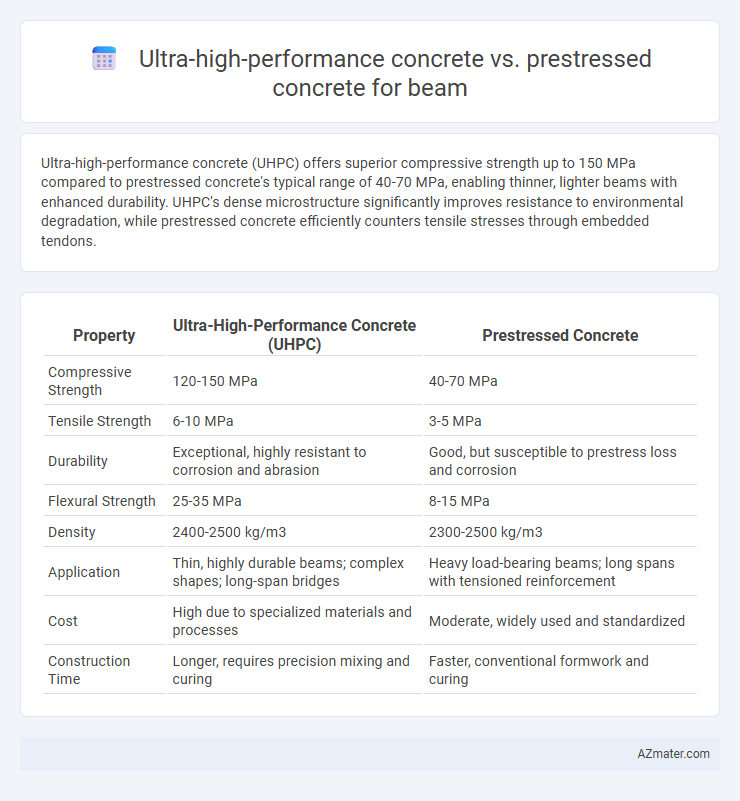Ultra-high-performance concrete (UHPC) offers superior compressive strength up to 150 MPa compared to prestressed concrete's typical range of 40-70 MPa, enabling thinner, lighter beams with enhanced durability. UHPC's dense microstructure significantly improves resistance to environmental degradation, while prestressed concrete efficiently counters tensile stresses through embedded tendons.
Table of Comparison
| Property | Ultra-High-Performance Concrete (UHPC) | Prestressed Concrete |
|---|---|---|
| Compressive Strength | 120-150 MPa | 40-70 MPa |
| Tensile Strength | 6-10 MPa | 3-5 MPa |
| Durability | Exceptional, highly resistant to corrosion and abrasion | Good, but susceptible to prestress loss and corrosion |
| Flexural Strength | 25-35 MPa | 8-15 MPa |
| Density | 2400-2500 kg/m3 | 2300-2500 kg/m3 |
| Application | Thin, highly durable beams; complex shapes; long-span bridges | Heavy load-bearing beams; long spans with tensioned reinforcement |
| Cost | High due to specialized materials and processes | Moderate, widely used and standardized |
| Construction Time | Longer, requires precision mixing and curing | Faster, conventional formwork and curing |
Introduction to Beam Construction Materials
Ultra-high-performance concrete (UHPC) offers superior compressive strength exceeding 150 MPa and enhanced durability compared to traditional materials, making it ideal for slender, longer-span beams with reduced cross-sections. Prestressed concrete, utilizing high-tensile steel tendons tensioned prior to loading, effectively counteracts tensile stresses, allowing beams to carry heavier loads and span greater distances without excessive deflection. Selecting between UHPC and prestressed concrete depends on structural requirements, cost considerations, and desired longevity in beam construction projects.
Defining Ultra-High-Performance Concrete (UHPC)
Ultra-High-Performance Concrete (UHPC) features a compressive strength exceeding 150 MPa, significantly higher than traditional prestressed concrete, with enhanced durability due to its dense microstructure and advanced fiber reinforcement. UHPC's exceptional tensile strength and fracture toughness enable the design of slimmer, lighter beams with longer spans and reduced maintenance. Compared to prestressed concrete beams, UHPC offers superior corrosion resistance and superior mechanical performance, making it ideal for innovative structural applications requiring extreme load-bearing capacity and longevity.
Overview of Prestressed Concrete
Prestressed concrete beams are engineered by applying pre-compression to the concrete through tensioned steel tendons, significantly enhancing load-bearing capacity and reducing tensile stress. This method allows for longer spans and thinner sections compared to conventional reinforced concrete, optimizing material usage and structural efficiency. Prestressed concrete is widely utilized in bridges and high-load structural applications where durability and minimized deflection are critical.
Comparative Strength Characteristics
Ultra-high-performance concrete (UHPC) exhibits significantly higher compressive strength, often exceeding 150 MPa, compared to prestressed concrete typically ranging between 40 to 70 MPa, enabling thinner, lighter beams with enhanced durability. The superior tensile strength of UHPC, due to its dense matrix and fiber reinforcement, reduces the reliance on prestressing tendons and allows for improved crack resistance under flexural loads. Prestressed concrete beams benefit from induced compressive stresses that counteract tensile forces, but UHPC's intrinsic material strength provides greater load-bearing capacity and longevity without extensive prestressing interventions.
Durability and Longevity Analysis
Ultra-high-performance concrete (UHPC) exhibits superior durability compared to prestressed concrete beams due to its dense microstructure, enhanced resistance to chloride penetration, and exceptional compressive strength exceeding 150 MPa, which significantly reduces the risk of cracking and corrosion. Prestressed concrete beams, while effective in managing tensile stresses through induced compressive forces, typically have lower durability under aggressive environmental conditions due to standard concrete's higher permeability and susceptibility to reinforcement corrosion. Long-term performance studies reveal UHPC beams maintain structural integrity and load-bearing capacity over extended service lives exceeding 100 years, whereas prestressed concrete beams often require more frequent maintenance and repair interventions within 50 to 75 years under similar exposure conditions.
Load-Bearing Capabilities
Ultra-high-performance concrete (UHPC) beams exhibit significantly enhanced load-bearing capabilities compared to traditional prestressed concrete due to their superior compressive strength, often exceeding 150 MPa, and exceptional tensile strength enabled by fiber reinforcement. UHPC's dense microstructure reduces crack propagation, resulting in higher durability and load resistance under dynamic and static loads. Conversely, prestressed concrete beams rely on applied tension in steel tendons to counteract tensile stresses, offering effective load transfer but generally lower ultimate strength than UHPC in equivalent beam cross-sections.
Cost Considerations and Economic Impact
Ultra-high-performance concrete (UHPC) beams exhibit higher initial material costs compared to prestressed concrete, driven by advanced additives and mixing processes. Despite the price premium, UHPC beams offer longer service life and reduced maintenance expenses, contributing to lower life-cycle costs in infrastructure projects. In contrast, prestressed concrete provides cost efficiency through established fabrication methods and widespread availability, although potentially incurring higher long-term repair costs.
Construction Methods and Installation Time
Ultra-high-performance concrete (UHPC) beams require meticulous mixing and specialized formwork due to their dense matrix and superior strength, often shortening curing times compared to traditional concretes. Prestressed concrete beams involve tensioning steel tendons before or after casting, necessitating complex stressing equipment and longer installation stages to ensure proper load distribution. UHPC installation generally allows faster on-site assembly and reduced formwork removal, while prestressed concrete demands careful handling and extended monitoring during the stressing process to prevent structural issues.
Sustainability and Environmental Impact
Ultra-high-performance concrete (UHPC) offers significant sustainability advantages over prestressed concrete for beams due to its superior durability and reduced material volume, which lowers carbon emissions associated with production and transportation. UHPC's dense microstructure enhances resistance to environmental degradation, extending the lifespan of structural elements and minimizing the need for repairs or replacements. In contrast, prestressed concrete often requires higher cement content and frequent maintenance, leading to a larger environmental footprint across the beam's lifecycle.
Choosing the Right Concrete for Beam Applications
Ultra-high-performance concrete (UHPC) offers superior compressive strength exceeding 150 MPa and enhanced durability, making it ideal for slender beams requiring high load capacity and corrosion resistance. Prestressed concrete beams utilize tensioned steel tendons to counteract tensile stresses, optimizing structural efficiency for longer spans and heavy loads. Selecting between UHPC and prestressed concrete depends on project requirements such as load conditions, span length, durability demands, and cost-effectiveness in beam design.

Infographic: Ultra-high-performance concrete vs Prestressed concrete for Beam
 azmater.com
azmater.com